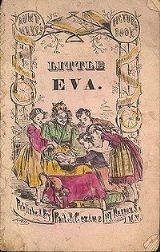
Little Eva: The Flower of the South
Encyclopedia
Little Eva: The Flower of the South is an 1853
children's novel
written by Philip J. Cozans.
that also contains elements of plantation literature
, a pro-slavery literary genre that emerged in the Southern United States
in reaction to the publication of Uncle Tom's Cabin
in 1852
.
The majority of plantation literature was written for an adult audience, such as Aunt Phillis's Cabin
(1852), Antifanaticism: A Tale of the South
(1853), and The Planter's Northern Bride
(1854). Little Eva breaks with this tradition and attempts to tell a children's story about slaves who are content with their lot and are treated fairly by their owners.
It is not clear, however, whether the Eva presented by Cozans is the same Eva introduced in Stowe's novel or a different character altogether, although the similarities between the two would suggest that this is the same Eva introduced in Uncle Tom's Cabin.
1853 in literature
The year 1853 in literature involved some significant new books.-Events:*Charles Dickens writes Bleak House, the first English novel to feature a detective.*William Wells Brown becomes the first African American novelist to be published.-New books:...
children's novel
Children's literature
Children's literature is for readers and listeners up to about age twelve; it is often defined in four different ways: books written by children, books written for children, books chosen by children, or books chosen for children. It is often illustrated. The term is used in senses which sometimes...
written by Philip J. Cozans.
Background
Little Eva is unique in being one of few known examples of children's literatureChildren's literature
Children's literature is for readers and listeners up to about age twelve; it is often defined in four different ways: books written by children, books written for children, books chosen by children, or books chosen for children. It is often illustrated. The term is used in senses which sometimes...
that also contains elements of plantation literature
Anti-Tom literature
Anti-Tom literature refers to the 19th century pro-slavery novels and other literary works written in response to Harriet Beecher Stowe's Uncle Tom's Cabin. Also called Plantation literature, these writings were generally written by authors from the Southern United States...
, a pro-slavery literary genre that emerged in the Southern United States
Southern United States
The Southern United States—commonly referred to as the American South, Dixie, or simply the South—constitutes a large distinctive area in the southeastern and south-central United States...
in reaction to the publication of Uncle Tom's Cabin
Uncle Tom's Cabin
Uncle Tom's Cabin; or, Life Among the Lowly is an anti-slavery novel by American author Harriet Beecher Stowe. Published in 1852, the novel "helped lay the groundwork for the Civil War", according to Will Kaufman....
in 1852
1852 in literature
The year 1852 in literature involved some significant new books.-New books:*Manuel Antônio de Almeida - Memoirs of a Police Sergeant*Wilkie Collins - Basil: A Story of Modern Life...
.
The majority of plantation literature was written for an adult audience, such as Aunt Phillis's Cabin
Aunt Phillis's Cabin
Aunt Phillis's Cabin; or, Southern Life As It Is by Mary Henderson Eastman is a plantation fiction novel, and is perhaps the most read anti-Tom novel in American literature. It was published by Lippincott, Grambo & Co of Philadelphia in 1852 as a response to Stowe's Uncle Tom's Cabin, published...
(1852), Antifanaticism: A Tale of the South
Antifanaticism: A Tale of the South
Antifanaticism: A Tale of the South is an 1853 plantation fiction novel by Martha Haines Butt.- Overview :Antifanaticism is one of several examples of the plantation literature genre that appeared in reaction to the anti-slavery novel Uncle Tom's Cabin by Harriet Beecher Stowe, which had been...
(1853), and The Planter's Northern Bride
The Planter's Northern Bride
The Planter's Northern Bride is an 1854 novel written by Caroline Lee Hentz, in response to the publication of Uncle Tom's Cabin by Harriet Beecher Stowe in 1852.- Overview :...
(1854). Little Eva breaks with this tradition and attempts to tell a children's story about slaves who are content with their lot and are treated fairly by their owners.
Plot introduction
Little Eva tells a simple tale of Eva, a young girl and the daughter of a plantation owner, who is well-behaved, polite, and intelligent. Eva, due to her kind-heartedness, teaches the child-slaves on the plantation how to read and write, and because of her kindness, the slaves, when they are set free, prefer to remain on the plantation with Eva as her friends.Relationship with Uncle Tom's Cabin
It is interesting to note that Uncle Tom's Cabin also featured a character named Little Eva, and who was also a kindhearted white girl who firmly believed in the idea of forgiveness and friendship, and was able to pacify the violent slave Topsy with her arguments.It is not clear, however, whether the Eva presented by Cozans is the same Eva introduced in Stowe's novel or a different character altogether, although the similarities between the two would suggest that this is the same Eva introduced in Uncle Tom's Cabin.

